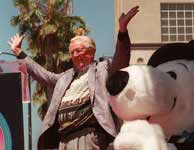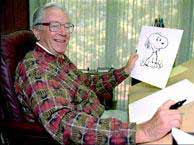VOICE ONE:
I'm Barbara Klein.
VOICE TWO:
And I'm Steve Ember with People in America in VOA Special English. Today we tell about Charles M. Schulz who wrote and drew the newspaper comic strip "Peanuts" for half a century.
(MUSIC)
VOICE ONE:

Millions of people around the world who loved the comic strip "Peanuts" were sad when Charles Schulz died in February, 2000. He was 77 years old. The artist who created Charlie Brown and his dog Snoopy had retired a month earlier because of poor health. The last new daily "Peanuts" appeared January 3rd in 2600 newspapers in 75 countries.
Charles Schulz drew "Peanuts" for 50 years. The comic strip first appeared in seven American newspapers in 1950. At that time, the subjects were all children and animals. They still are. People love these characters because they demonstrate the failings and strengths of all human beings. For example, Charlie Brown usually cannot get things right. But he tries his best. And he never stops trying.
VOICE TWO:
Charles Schulz would not permit anyone else to draw "Peanuts." However, the stories about Charlie Brown and his friends did not completely disappear when their creator died.
Newspapers are publishing earlier "Peanuts" comic strips, called "Classic Peanuts." Special programs based on stories about the "Peanuts" group are still shown on television and performed as musical plays.
VOICE ONE:
For example, the animated cartoon, "A Charlie Brown Christmas," has appeared on television since 1965. In it, Charlie Brown has to choose a Christmas tree for a special Christmas program. He gets a small ugly tree because he feels sorry for it. But the other children laugh at it. They say Charlie Brown has failed again to do something right. Then in preparing for the show, one of the children tells about the true meaning of Christmas. The other children decide that maybe they can make Charlie Brown's tree look beautiful.
Here is some jazz music by the Vince Guaraldi Trio from the television show, "A Charlie Brown Christmas."
(MUSIC)
VOICE TWO:
Other children often criticize Charlie Brown. He suffers many losses and rejections -- just as people sometimes do in real life. His baseball team always loses. He keeps trying to kick a football, but never succeeds. His friend Lucy keeps pulling the ball away. But he continues to believe that some day she will let him kick the ball.
VOICE ONE:

Charlie Brown has a dog named Snoopy who may be even more popular than Charlie. Snoopy is a funny character. He sleeps on top of his dog house. Snoopy is always trying to write the great American novel. But he cannot get beyond the first line of his book. He writes: "It was a dark and stormy night" again and again. Snoopy dreams of himself as a pilot searching for the Red Baron, a famous German fighter pilot in World War One.
VOICE TWO:
There are other memorable characters in the "Peanuts" comic strip. Lucy mistrusts everyone. She often seems angry. Schroeder plays a small toy piano. Every year he celebrates the birthday of composer Ludwig von Beethoven. Linus always carries a blanket to feel secure. Peppermint Patty is good at sports. She likes Charlie Brown very much and is the only one who calls him "Chuck."
Charles Schulz said he saw himself in some of his characters. He recognized himself in Charlie Brown's continued failures. In Snoopy's humor. In Lucy's moments of anger. And in the insecure feelings of Linus. Some of the situations in "Peanuts" seem to have developed from Mr. Schulz's own life experiences.
VOICE ONE:
In 1967, the "Peanuts" characters starred in a musical play. "You're A Good Man, Charlie Brown" was first performed in New York City. It later became the most produced musical in America. A new production opened on Broadway in New York in 1999. The actors in the Broadway version of the musical sing a song called "Happiness."
(MUSIC)
VOICE TWO:
Charles Schulz brought happiness to millions of people. He was born in 1922 in Minneapolis, Minnesota. His father was a barber who cut men's hair. When Charles was five, his teacher told him: "Some day, Charles, you are going to be an artist." But he sometimes had trouble with his school work. In high school, he was poor at sports. He was afraid to ask a girl to go out with him. His high school publication rejected some of his drawings he hoped it would publish.
At age 17, Charles began studying art. He took a class by mail from a Minnesota art school. This was the only art education he ever had.
VOICE ONE:
Then came World War Two. Mr. Schulz served in the United States Army. During this period he very much enjoyed a comic strip about soldiers called "Willie and Joe."
Cartoonist Bill Mauldin drew this strip. Charles Schulz had Snoopy remember Bill Mauldin every year on the American holiday that honors former soldiers.
VOICE TWO:

After the war, Mr. Schulz taught at an art school. He fell in love with another employee. She was a young woman with red hair. However, this red-haired woman married someone else. Mr. Schulz said he thought she chose another man because her mother believed Charles Schulz would never succeed in life.
This woman's rejection must have been painful for Mr. Schulz. Yet in later years he developed the failed romance into an interesting situation for "Peanuts." The red-haired woman became the little red-haired girl Charlie Brown likes so much. True to history, this girl does not care much for Charlie Brown. But he never stops thinking she is wonderful.
VOICE ONE:
In 1947, a newspaper in Saint Paul, Minnesota, began publishing a comic written and drawn by Charles Schulz. It was called "L'il Folks." It showed a little boy with a round face named Charlie Brown. The newspaper published the single drawing once each week.
But it refused to use it every day, as Mr. Schulz had hoped. So he began creating a comic strip of several drawings for a media company, United Feature Syndicate. It sold the strip to newspapers around the country to be published every day. The media company changed the name of the strip to "Peanuts."
VOICE TWO:
Over the years Mr. Schulz drew about 18,000 comic strips. He did it without any help. This is very unusual for a comic strip artist. Most have people who help them draw the strips. Charles Schulz also wrote the stories for the television and film productions of "Peanuts." There have been more than 50 animated television shows based on "Peanuts." Charles Schulz's comic strip created a whole industry. There are "Peanuts" toys, videos, clothes and greeting cards. A number of parks in the United States and in Asia use "Peanuts" characters.
(MUSIC)
VOICE ONE:
In 2002, a new museum opened in Santa Rosa, California. It celebrates the life and work of the creator of "Peanuts." Charles Schulz agreed to the idea of a museum before he died.
It provides a place where people can see the first drawings of all his comic strips and learn about his work. The museum also shows works by other artists that honor "Peanuts".
VOICE TWO:
The museum was built very near the place where Charles Schulz wrote and drew "Peanuts." One area of the museum re-creates the room where Charles Schulz drew his cartoons. Another area shows things from his childhood and awards he received. His wife Jean said she wanted the museum to show not only his work, but also how he lived. Mrs. Schulz said she wants visitors to feel as if they are taking part in his daily life.
(MUSIC)
VOICE ONE:
This program was written by Jerilyn Watson. It was produced by Lawan Davis. I'm Barbara Klein.
VOICE TWO:
And I'm Steve Ember. Join us again next week for People in America in VOA Special English.
comic strip: a sequence of drawings telling a story in a newspaper or comic book 连环漫画
Related stories:
Les Paul's electric guitar and inventions changed 20th century popular music
Katharine Hepburn: an independent and intelligent actress
Diane Arbus, 1923-1971: Photographer who found unusual people
Leonard Bernstein, 1918-1990: musical great
(Source: VOA 英语点津编辑)